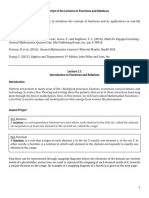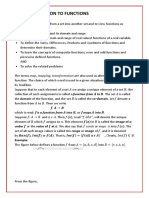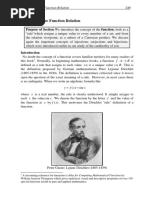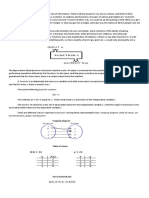Functions PDF
Uploaded by
Stevenzel Eala EstellaFunctions PDF
Uploaded by
Stevenzel Eala Estella1
MATH 114 – differential calculus
Handout #1
Historical Background of the Calculus
Some of the ideas of calculus can be found in the works of
the ancient Greek mathematicians at the time of Archimedes (287
– 212 B.C.) and in the works of the early seventeenth century by
Rene Descartes (1596 – 1650), Pierre de Fermat (1601 – 1665),
John Wallis (1616 – 1703), and Isaac Barrow (1630 – 1677).
However, the invention of calculus is often attributed to Sir Isaac
Newton (1642 – 1727) and Gottfried Wilhelm Leibniz (1646 –
1716) because they began the generalization and unification of
the subject. There were other mathematicians of the seventeenth
and eighteenth centuries who joined in the development of the
calculus; some of them were Jakob Bernoulli (1654 – 1705),
Johann Bernoulli (1667 – 1748), Leonhard Euler (1707 – 1783),
and Joseph Lagrange (1736 – 1813). However, it wasn’t until the nineteenth century that the processes
of calculus were given a sound foundation by such mathematicians as Bernhard Bolzano (1781 –
1848), August Cauchy (1789 – 1857), Karl Weierstrass (1815 – 1897), and Richard Dedekind (1831 –
1916).
Preliminaries
Functions and Relations
A relation is any set of ordered pairs ( x, y) where x
belong to one set and y belongs to another set. The set of all
x is called the domain while the set of all
first elements
second elements y will constitute the range. A relation can
also be defined as the set of ordered pairs ( x, y) such that
for everyx element of the domain, there will be at least one
element y of the range.
We can express a relation in different ways:
Listing ordered pairs, say (0, 5),(1, 1),(2,3)
Using set notation, say ( x, y) | x2 y 2 25
Describing the elements by an equation, say y 4x 5 or x2 y 2 25
Using graphs:
Panopio, F.M. Simplified Differential Calculus. Feliber Publishing House. 1998
Leithold,Louis. The Calculus 7. Pearson Education Asia Pte Ltd. 2002
Arcega, V.D. College Algebra Made Easy. G&P Printing Press. Lipa City. 2010
2
Example 1.
F (1,1),(1,2),(2,3),(3,7)
Example 2.
G (0, 2),(2,0),(3,1),(4,2)
In some cases, the domain of the relation is not easily determined.
Example 3.
E ( x, y) | y x 9
Example 4.
x
y
x2 4
Example 5.
y x2 9
Example 6.
1
y
x5
Panopio, F.M. Simplified Differential Calculus. Feliber Publishing House. 1998
Leithold,Louis. The Calculus 7. Pearson Education Asia Pte Ltd. 2002
Arcega, V.D. College Algebra Made Easy. G&P Printing Press. Lipa City. 2010
3
Functions and Functional Notations
A function is a relation in which no two distinct ordered pairs ( x, y) have the same first
element. Therefore, a function is a special type of relation which is either one to one or many to one.
Furthermore, all functions are relations but not all relations are functions.
In this definition, the restriction that no two distinct ordered pairs can have the same first number
ensures that y is unique for a specific value of x . The symbols x and y denote variables. Because
the value of y is dependent on the choice of x , x denotes the independent variable and y denotes
the dependent variable.
For example, the set of ordered pairs (1,5),(5,3),(3,7) is a function because the first element of
each ordered pair is unique; while the set of ordered pairs (1, 2),(1,3),(3,5) is a mere relation since in
the latter, (1, 2) and (1,3) are two ordered pairs which have the same first element.
Another way to determine whether a relation is a function or not is by using the vertical line
test. If a vertical line intersects the graph of a relation at more than one point, then the relation is not a
function.
Every function will be denoted by a symbol which is usually a letter such as: f , F , g , G, h, H and
others. Therefore, if f is a function involving variables x and y , that is, ( x, y) f , then we can write
the second coordinate y by the symbol f ( x) which is read as “ f of x .” As a result, the ordered pair
( x, y) can be written as ( x, f ( x)) since y f ( x) . This equation y f ( x) is the most common way of
writing a function. The notation f ( x) , called a function value, is due to the Swiss mathematician and
physicist Leonhard Euler (1707 – 173).
Example 7. Given the function f ( x, y) | y x 2; x 0, 2,3, 4 , determine the range of the
function f .
Panopio, F.M. Simplified Differential Calculus. Feliber Publishing House. 1998
Leithold,Louis. The Calculus 7. Pearson Education Asia Pte Ltd. 2002
Arcega, V.D. College Algebra Made Easy. G&P Printing Press. Lipa City. 2010
4
Example 8. If f ( x) 3x2 5 , find f (1) , f (3) , f (a) , and f (4h 1) .
Example 9. Given g ( x) 4x , find a.) g (0) b.) g 1 2 , and c.) g 2 .
f ( x h) f ( x )
Example 10. Find where h 0 , if (a) f ( x) 4x2 5x 7 ; (b) f ( x) x
h
Panopio, F.M. Simplified Differential Calculus. Feliber Publishing House. 1998
Leithold,Louis. The Calculus 7. Pearson Education Asia Pte Ltd. 2002
Arcega, V.D. College Algebra Made Easy. G&P Printing Press. Lipa City. 2010
5
Graph of a Function
The graph of a function, or in general an equation, is the geometric representation of all the points
that satisfy the given function or equation.
If f is a function, then the graph of f is the set of all points ( x, y) in the plane R 2 for which
( x, y) is an ordered pair in f .
From this definition, the graph of a function f is the same as the graph of the equation
y f ( x) .
For simple functions, like those given as a set of few elements like F (1,2),(3,3),(4,2),(2,4)
the graph is done by just plotting these four points in the xy -plane.
Similarly, when the function is given in equation form but is linear like x 2 y 2 , the graph will
be easily done by getting two points, plotting them in the xy -plane and then joining them using a
straight edge or ruler.
However, when the equation is of higher degree, the tabular form or point-plotting method may
not be enough. Other information about the graph of the given equation is needed. For example, the
intercepts will help determine where the curve will cross the x and y axes. Tests for symmetry will
help minimize the tabular values needed. Asymptotes or guiding lines will determine boundaries in the
xy -plane where the graph can go. Even the domain and range will always be of help.
Example 11. Find the domain and range of y x 1 . Sketch its graph and determine if it is a
function or not.
Panopio, F.M. Simplified Differential Calculus. Feliber Publishing House. 1998
Leithold,Louis. The Calculus 7. Pearson Education Asia Pte Ltd. 2002
Arcega, V.D. College Algebra Made Easy. G&P Printing Press. Lipa City. 2010
6
You have seen that the domain of a function can usually be determined by the function’s
definition. Often the range can b determined by the graph of the function as in the next example
involving a piecewise-defined function, one that is defined by using more than one expression.
Example 11.
Let f be the function defined by
x 1 if x 3
f ( x) 5 if x 3
2 x 1 if 3 x
Determine the domain and range of f and sketch its graph.
Example 12. Let g be the function defined by
3x 2 if x 1
g ( x)
x
2
if 1 x
Determine the domain and range of g and sketch its graph.
Panopio, F.M. Simplified Differential Calculus. Feliber Publishing House. 1998
Leithold,Louis. The Calculus 7. Pearson Education Asia Pte Ltd. 2002
Arcega, V.D. College Algebra Made Easy. G&P Printing Press. Lipa City. 2010
7
x2 9
Example 13. The function h is defined by h( x) . Determine the domain and range of h and
x 3
sketch its graph.
x 3 if x3
Example 14. Let H be the function defined by H ( x)
2 if x3
Determine the domain and range of H and sketch its graph.
Panopio, F.M. Simplified Differential Calculus. Feliber Publishing House. 1998
Leithold,Louis. The Calculus 7. Pearson Education Asia Pte Ltd. 2002
Arcega, V.D. College Algebra Made Easy. G&P Printing Press. Lipa City. 2010
8
x2 if x2
Example 15. The function f is defined by f ( x)
7 if x2
Determine the domain and range of f and sketch its graph.
Example 16. Determine the domain and range of the function f such that f ( x) x .
Panopio, F.M. Simplified Differential Calculus. Feliber Publishing House. 1998
Leithold,Louis. The Calculus 7. Pearson Education Asia Pte Ltd. 2002
Arcega, V.D. College Algebra Made Easy. G&P Printing Press. Lipa City. 2010
You might also like
- AP Physics Laboratory Galileo's Inclined Plane: at T V DNo ratings yetAP Physics Laboratory Galileo's Inclined Plane: at T V D2 pages
- Lesson 1 - Functions, Function Notation, Domain & RangeNo ratings yetLesson 1 - Functions, Function Notation, Domain & Range27 pages
- The Coming Paradigm Shift in Forensic Identificationscience - Saks Science 2005No ratings yetThe Coming Paradigm Shift in Forensic Identificationscience - Saks Science 20055 pages
- LESSON 2.3: The Language of Relations and FunctionsNo ratings yetLESSON 2.3: The Language of Relations and Functions5 pages
- Chapter 3 - Functions With Solution20 Jun2013No ratings yetChapter 3 - Functions With Solution20 Jun201349 pages
- Precalculus: Quarter I - ILM 2 FunctionsNo ratings yetPrecalculus: Quarter I - ILM 2 Functions15 pages
- Lesson 4. The Language of Relations and FunctionsNo ratings yetLesson 4. The Language of Relations and Functions7 pages
- 01 Functions, Function Notation, Domain & RangeNo ratings yet01 Functions, Function Notation, Domain & Range27 pages
- Lecture Transcript 1 (Introduction To Functions and Piecewise Functions)No ratings yetLecture Transcript 1 (Introduction To Functions and Piecewise Functions)15 pages
- College and Advanced Algebra Handout # 1 - Chapter 1. FunctionsNo ratings yetCollege and Advanced Algebra Handout # 1 - Chapter 1. Functions8 pages
- Functions, Limits, Continuity: Function Ornota Function?No ratings yetFunctions, Limits, Continuity: Function Ornota Function?32 pages
- RELATIONS-AND-FUNCTIONS (Mathematics in The Modern World)No ratings yetRELATIONS-AND-FUNCTIONS (Mathematics in The Modern World)38 pages
- Lecture Transcript 1 Introduction To Functions and Piecewise Functions7No ratings yetLecture Transcript 1 Introduction To Functions and Piecewise Functions714 pages
- A. Definition of A Function: Video Tutorial For Parts A, B, CNo ratings yetA. Definition of A Function: Video Tutorial For Parts A, B, C10 pages
- General Mathematics: Grade 11 Chapter 1: Functions A Brief History of FunctionNo ratings yetGeneral Mathematics: Grade 11 Chapter 1: Functions A Brief History of Function5 pages
- QS015 - Chapter 5 Functions & Graphs PDFNo ratings yetQS015 - Chapter 5 Functions & Graphs PDF24 pages
- Topic 3 Functions and Relations Notes 2023No ratings yetTopic 3 Functions and Relations Notes 202365 pages
- ENGGMATH2 MODULE 1 Functions, Limits, Continuity NOTESNo ratings yetENGGMATH2 MODULE 1 Functions, Limits, Continuity NOTES32 pages
- Concepts in Calculus I - Beta Version - 2011 - Miklos Bona - Sergei ShabanovNo ratings yetConcepts in Calculus I - Beta Version - 2011 - Miklos Bona - Sergei Shabanov188 pages
- Chapter 4 Structure and Properties of Water 2017-2018No ratings yetChapter 4 Structure and Properties of Water 2017-201833 pages
- Lesson 4 Derivative of Inverse Hyperbolic FunctionsNo ratings yetLesson 4 Derivative of Inverse Hyperbolic Functions8 pages
- Institute of Graduate Studies: Romblon State University Odiongan, RomblonNo ratings yetInstitute of Graduate Studies: Romblon State University Odiongan, Romblon4 pages
- Lesson 3 Derivative of Hyperbolic FunctionsNo ratings yetLesson 3 Derivative of Hyperbolic Functions13 pages
- Lesson 1 Derivative of Trigonometric FunctionsNo ratings yetLesson 1 Derivative of Trigonometric Functions17 pages
- Lesson 13 Volume of Solids of RevolutionNo ratings yetLesson 13 Volume of Solids of Revolution21 pages
- Users of Accounting Information Learning Objective: Key UnderstandingNo ratings yetUsers of Accounting Information Learning Objective: Key Understanding4 pages
- At The End of The Course, The Student Would Have100% (1)At The End of The Course, The Student Would Have4 pages
- Laplace Transforms: Mr. Mark Anthony Garcia, M.S. de La Salle UniversityNo ratings yetLaplace Transforms: Mr. Mark Anthony Garcia, M.S. de La Salle University18 pages
- Eng 03-Speech Communication Topic One Speech: Its Nature and ImportanceNo ratings yetEng 03-Speech Communication Topic One Speech: Its Nature and Importance4 pages
- Understanding The Difference Between Negative and Positive FreedomNo ratings yetUnderstanding The Difference Between Negative and Positive Freedom3 pages
- What Shapes Culture: Political LeadershipNo ratings yetWhat Shapes Culture: Political Leadership16 pages
- Psychology of Time: John G. Kuna, Psyd and AssociatesNo ratings yetPsychology of Time: John G. Kuna, Psyd and Associates18 pages
- Variable and Its Kinds: Grade 12 - Practical Research 2No ratings yetVariable and Its Kinds: Grade 12 - Practical Research 25 pages
- Ngg. YO UN G: Calibration Services PVT LTDNo ratings yetNgg. YO UN G: Calibration Services PVT LTD2 pages
- Bendixson-Dulac Criterion and Reduction To Global Uniqueness in The Problem of Estimating The Number of Limit CyclesNo ratings yetBendixson-Dulac Criterion and Reduction To Global Uniqueness in The Problem of Estimating The Number of Limit Cycles9 pages
- Distributed Leadership in Higher Education: Richard Bolden, Georgy Petrov and Jonathan GoslingNo ratings yetDistributed Leadership in Higher Education: Richard Bolden, Georgy Petrov and Jonathan Gosling21 pages
- Pengaruh Karakteristik Individu Terhadap Kinerja Karyawan Pada PT Sumber Alfaria Trijaya Di MakassarNo ratings yetPengaruh Karakteristik Individu Terhadap Kinerja Karyawan Pada PT Sumber Alfaria Trijaya Di Makassar13 pages
- Analyzing Needs Analysis in ESP: A (Re) Modeling: Vali Mohammadi, Nasser MousaviNo ratings yetAnalyzing Needs Analysis in ESP: A (Re) Modeling: Vali Mohammadi, Nasser Mousavi7 pages
- AERO2379 & AERO2350 Lecture 5 Prezzi Style - 24 Mar 2020-1No ratings yetAERO2379 & AERO2350 Lecture 5 Prezzi Style - 24 Mar 2020-171 pages
- AP Physics Laboratory Galileo's Inclined Plane: at T V DAP Physics Laboratory Galileo's Inclined Plane: at T V D
- Lesson 1 - Functions, Function Notation, Domain & RangeLesson 1 - Functions, Function Notation, Domain & Range
- The Coming Paradigm Shift in Forensic Identificationscience - Saks Science 2005The Coming Paradigm Shift in Forensic Identificationscience - Saks Science 2005
- LESSON 2.3: The Language of Relations and FunctionsLESSON 2.3: The Language of Relations and Functions
- Lecture Transcript 1 (Introduction To Functions and Piecewise Functions)Lecture Transcript 1 (Introduction To Functions and Piecewise Functions)
- College and Advanced Algebra Handout # 1 - Chapter 1. FunctionsCollege and Advanced Algebra Handout # 1 - Chapter 1. Functions
- Functions, Limits, Continuity: Function Ornota Function?Functions, Limits, Continuity: Function Ornota Function?
- RELATIONS-AND-FUNCTIONS (Mathematics in The Modern World)RELATIONS-AND-FUNCTIONS (Mathematics in The Modern World)
- Lecture Transcript 1 Introduction To Functions and Piecewise Functions7Lecture Transcript 1 Introduction To Functions and Piecewise Functions7
- A. Definition of A Function: Video Tutorial For Parts A, B, CA. Definition of A Function: Video Tutorial For Parts A, B, C
- General Mathematics: Grade 11 Chapter 1: Functions A Brief History of FunctionGeneral Mathematics: Grade 11 Chapter 1: Functions A Brief History of Function
- ENGGMATH2 MODULE 1 Functions, Limits, Continuity NOTESENGGMATH2 MODULE 1 Functions, Limits, Continuity NOTES
- Concepts in Calculus I - Beta Version - 2011 - Miklos Bona - Sergei ShabanovConcepts in Calculus I - Beta Version - 2011 - Miklos Bona - Sergei Shabanov
- Chapter 4 Structure and Properties of Water 2017-2018Chapter 4 Structure and Properties of Water 2017-2018
- Lesson 4 Derivative of Inverse Hyperbolic FunctionsLesson 4 Derivative of Inverse Hyperbolic Functions
- Institute of Graduate Studies: Romblon State University Odiongan, RomblonInstitute of Graduate Studies: Romblon State University Odiongan, Romblon
- Users of Accounting Information Learning Objective: Key UnderstandingUsers of Accounting Information Learning Objective: Key Understanding
- Laplace Transforms: Mr. Mark Anthony Garcia, M.S. de La Salle UniversityLaplace Transforms: Mr. Mark Anthony Garcia, M.S. de La Salle University
- Eng 03-Speech Communication Topic One Speech: Its Nature and ImportanceEng 03-Speech Communication Topic One Speech: Its Nature and Importance
- Understanding The Difference Between Negative and Positive FreedomUnderstanding The Difference Between Negative and Positive Freedom
- Psychology of Time: John G. Kuna, Psyd and AssociatesPsychology of Time: John G. Kuna, Psyd and Associates
- Variable and Its Kinds: Grade 12 - Practical Research 2Variable and Its Kinds: Grade 12 - Practical Research 2
- Bendixson-Dulac Criterion and Reduction To Global Uniqueness in The Problem of Estimating The Number of Limit CyclesBendixson-Dulac Criterion and Reduction To Global Uniqueness in The Problem of Estimating The Number of Limit Cycles
- Distributed Leadership in Higher Education: Richard Bolden, Georgy Petrov and Jonathan GoslingDistributed Leadership in Higher Education: Richard Bolden, Georgy Petrov and Jonathan Gosling
- Pengaruh Karakteristik Individu Terhadap Kinerja Karyawan Pada PT Sumber Alfaria Trijaya Di MakassarPengaruh Karakteristik Individu Terhadap Kinerja Karyawan Pada PT Sumber Alfaria Trijaya Di Makassar
- Analyzing Needs Analysis in ESP: A (Re) Modeling: Vali Mohammadi, Nasser MousaviAnalyzing Needs Analysis in ESP: A (Re) Modeling: Vali Mohammadi, Nasser Mousavi
- AERO2379 & AERO2350 Lecture 5 Prezzi Style - 24 Mar 2020-1AERO2379 & AERO2350 Lecture 5 Prezzi Style - 24 Mar 2020-1















































































































